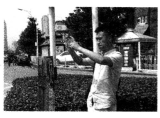题目内容
根据短文内容,从短文的选项中选出能填入空白处的最佳选项。选项中有两项为多余选项。
Instagram(抓拍神器)is a game.Getting likes and followers is no easy task.My sister routinely breaks 150 likes on Instagram,no sweat,because she just gets it.1. Here’s what to do and,more important,what not to do.
1. 2.
You can’t post photos optionally.Think of it like stealing grapes at the grocery store when a clerk isn’t watching.So when DO you actually post? Sunday evening is“prime time”for likes.because“everyone is bored and not doing homework.”I guess that applies to the real world too!
When not to post? Mornings! The likes are“strange and sporadic(零散的).”
2.Also,don’t post too much.
I don’t care how much you’re feeling your look. 3. This isn’t a buffet:we want a very small piece of your life.Remember,“You can’t give the people too much or they will pass their eye over it quickly.”If you’re posting three to four times a week,others may“reevaluate your life”.I see no lies!!!
3.But if it is a big week in your life,feel free to post more than usual.
Of course,there’s always the exception to the rule. 4. The social media shouldn’t punish you for having a lot going on! Just remember to take it easy after.
4.5.
a.Be“natural and fun”.
b.Selfies are“not to be taken seriously”.
c.“Selfies should only be when you have a good one.”

A.Selfies have strict rules.
B.Wait a while before Selfies again.
C.Timing is everything.
D.No one needs to see eight pictures from your date night out.
E.After all,Instagram was meant to record important moments in your life.
F.Just make sure you post afterwards and let the people want more.
G.Thankfully she was able to take time out of her busy schedule and break down the science of Instagram for us“old”folk.
 新课标阶梯阅读训练系列答案
新课标阶梯阅读训练系列答案
